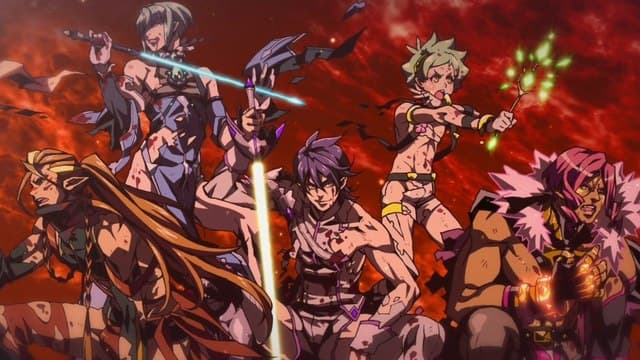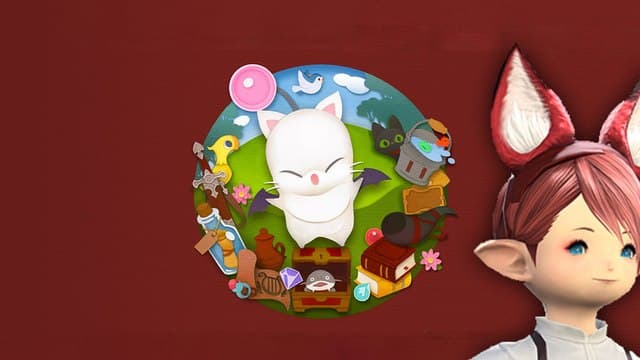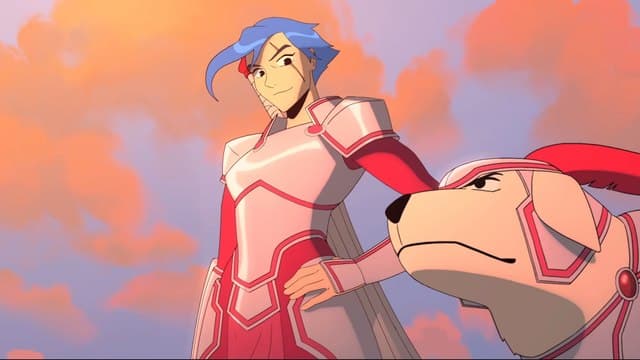Some of Inu-Oh‘s most gorgeous visuals don’t even involve its centerpiece, a series of musical performances flagrantly anachronistic to its setting in 14th-century feudal Japan. Instead, they’re all about Tomona, who was struck blind as a boy by the light of a legendary sword. To convey his POV, one scene shows the rain outlining the otherwise invisible buildings within the blank void of his vision. In other scenes, his senses paint a shifting watercolor picture of the world, or draft a sketchy outline of it. As he grows up early in the film, he gets used to living this way, falling in with a band of bald, blind monks who sing old stories while playing the biwa.
But when first meeting the outcast boy who will later call himself Inu-Oh, Tomona can hardly make sense of him. His most prominent feature is one arm that’s much longer than the rest of him. Sleeved in mismatched cloth sewn end to end, the arm billows behind him like a tail. He also wears a custom mask that looks like a wooden gourd, with holes in the top and bottom so his lopsided eyes can see. To Tomona, Inu-Oh’s movements are so foreign that he first appears as a colorful cloud, a whirlwind blowing through a dim, dark-colored world like the Tasmanian Devil from Looney Tunes. He likes to frighten people by showing them what’s beneath his mask, but Tomona is the first who doesn’t run. He doesn’t see anything to be afraid of.
So begins a fated collab for the ages in director Masaaki Yuasa’s energetic adaptation of the novel Tales of the Heike: Inu-Oh by Hideo Furukawa. This intense central friendship puts the film in line with various other Yuasa projects, from Devilman Crybaby to Keep Your Hands Off Eizouken to Ping Pong: The Animation (whose author contributed character designs to this film). And having recently stepped back from directing at Science Saru, the anime studio he co-founded, it’s certainly tempting to read Inu-Oh as a cap on an especially prolific period of Yuasa’s eclectic career.
They Don’t Kiss, By the Way
The lengthy timeline and historical backdrop give Inu-Oh a certain distinct weight, and it’s only enhanced by what ends up being some of the most detailed, fluid animation from Science Saru. The title character’s unconventional anatomy is a particular highlight, as features like his elongated arm figure into his own distinct version of noh theater. He physically changes after each appearance, embodying the mental and bodily transformations that pervade Yuasa’s work. His chosen name, Inu-Oh, means “King of Dogs” and ties back to the first time we see him in the film, as a squat feral child sleeping among the animals. After a dance, his form permanently elongates, and he takes the opportunity to cause gleeful havoc on the society that rejects him. Until he meets Tomona, that is.
Inu-Oh’s father refuses to let him perform, disgusted by his appearance. As a result, Inu-Oh strikes out on his own with Tomona, who functions like his hype man. Playing his biwa alongside taiko drummers, Tomona performs in the street to spread the word and drum up interest in Inu-Oh’s performances. To differentiate their style from their sedate peers, Inu-Oh depicts these performances as rock music. Tomona’s biwa becomes more or less an electric guitar, which he plays behind his back while howling and shouting at a crowd that’s screaming for more.
Inu-Oh’s own gigs have an operatic quality that recalls Freddie Mercury and Queen. But while there’s an emphasis on the stagecraft used to juice up these performances, the film pointedly avoids cutting away from either Tomona or Inu-Oh. There’s no imaginary, dreamlike depiction of how the songs makes people feel, of the place the music seems to transport them. Instead, Yuasa grounds us in a you-are-there perspective, laser-focused on the stage and the people around it.
While this choice does highlight all the intricacies of the animation and the choreography along with some catchy songs, it also grows a little wearying over time. So many of the performances are shown straight through, one leading to another with no interruption. By the time the film finally takes a breather for some background political machinations, its music sequences haven’t quite worn out their welcome, but they’ve certainly lost some of that initial thrill.

Somebody to Love (Platonically)
It’s tough to shake the feeling that less might have been more in this case, especially because the wall-to-wall shows give you a little too much time to scrutinize them. I’m not particularly versed in noh and Japanese history, so perhaps there are details I’m just missing, but I grew to question whether the rock music conveys the right feeling. It’s something we the audience recognize, and once the initial shock of seeing it mixed with these period trappings wears off, it’s no longer giving us the sense of something innovative and iconoclastic. It also doesn’t make a lot of sense — the film frames Inu-Oh’s story as an instance of forgotten, stolen culture left out of the official records, and it does that with rock music, a genre that itself has a checkered history of erasing the artists who originated it.
But even if we allow that I’m nit-picking an abstract bit of expression that we’re not supposed to squint at this hard, the overall film comes to a rather abrupt end. It doesn’t dig into the parallels it even seems to explicitly intend, like how the monks whisper their disapproval about Tomona not only for perverting their art but for how he looks. With his makeup, his flowery clothing, and his long hair, the bald monks liken him to “a prostitute.”
Tomona is pretty plainly going through a parallel transformation, even changing his name at various points to “Tomoichi” (initially out of respect for the monks) and “Tomoari” (upon developing his own style) before going back to his birth name. By contrast, Inu-Oh’s transformations reshape his appearance into something more conventional and accepted. I kept expecting this to come to a head, but it never really does.
I don’t know how the book goes, or if I’m supposed to fill in the blanks through some further stories the target audience would probably know (Science Saru has also produced a standalone historical TV series, The Heike Story). What I do know is that I can’t shake the sense that Inu-Oh has swept some of its dramatic potential under the rug, choosing to focus instead on the joy of meeting someone new and then making something with them. It gets that idea across through an array of impressively-animated performances, but it’s missing what happens when that collaboration dissolves.


